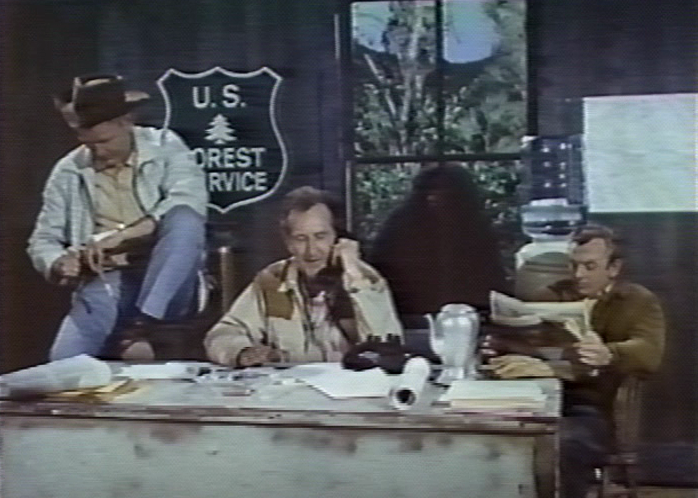
VIDEO ODDITIES,
or VHS: video house safari
~ by JOHN CRIBBS ~
 For those just tuning in: what I'm doing in this series is heading down to the local video store and finding interesting movies I've never heard of. For younger readers, a "video store" is an establishment that you can walk or drive to and rent Video Home System cassettes, also known as VHS tapes, from an actual person and take it home for your own entertainment purposes (you gotta bring it back to the store when you're done, though.)
For those just tuning in: what I'm doing in this series is heading down to the local video store and finding interesting movies I've never heard of. For younger readers, a "video store" is an establishment that you can walk or drive to and rent Video Home System cassettes, also known as VHS tapes, from an actual person and take it home for your own entertainment purposes (you gotta bring it back to the store when you're done, though.)
I'm basing my selections on the outrageous video boxes, the kind that helped us decide whether a movie looked like it was worth our time back in the days before the internet started telling us everything there is to know about every film before they're even released. Then I'm writing about my VHS safari.
With the inevitable extinction of the video store it's become more difficult to hunt down some of these more obscure titles... they're becoming harder to find than Bigfoot.
And the obsolescence is almost complete. All three Blockbusters in my area just went bust. Part of me wants to celebrate the imminent death of the soulless corporation that employed fascist policies as to what titles they stocked, that killed so many great independent video stores, but mostly it just makes me sad. The end of the most powerful rental company on the planet is the Seven Chalices Full of Plagues for the industry; that is, the second to last sign of its demise.
The next stage will be the discontinuation of packaged media, followed by the dissolution of video streaming - not in the near future mind you, probably not until they figure out how to channel movies and tv shows directly to the human brain. I guess that'll be fine...but it will be hard to determine whether or not they're any good without a video box.
{the VIDEO ODDITIES index}
video oddity #9:
BIGFOOT
robert f. slatzer, 1970
"Extraordinary claims require extraordinary evidence."
- Carl Sagan
"Maybe they don't exist, but I want them to."
- Jane Goodall
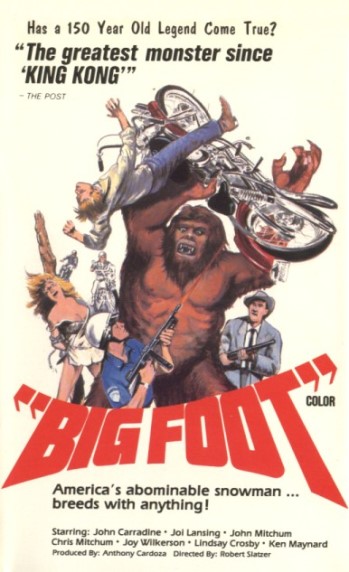
I can tell you why Bigfoot is real.
As I was getting started on this article in late March, a video was released by one Thomas Byers, depicting a Bigfoot walking across Golden Valley Church Road in Rutherford County, Tennessee. "As I filmed it crossing the road it turned its head towards me and snarled or growled at me as it ran across the road," Byers said in an excited statement. "It was truly one of the
most amazing sights I have ever seen." (One of the most?) However the footage came about, it's got the three B's of a classic Bigfoot video: bumpy, blurry and brief. These qualities are what connect this latest clip to the hundreds if not thousands of recorded alleged Bigfoot sightings brought to the public eye since the 1967 Patterson-Gimlin film, arguably the most iconic American home movie not shot by Abraham Zapruder. To skeptics, the poor quality of the footage is intentional desecration of the
image on the part
of the cameraman to hide the zipper on the gorilla costume or make the shooting of the film seem more abrupt and unexpected. But I think it's more interesting to look at it through the eyes of a believer. With today's technology, where any boob could CG a Bigfoot or any amateur creature makeup artist could create a mask that looks as good as the one in those commercials, we're still getting grainy footage of a blurry behemoth crossing the road. Why would you try to pass this off when you could easily
make a video with a tuxedo-wearing Bigfoot skydiving onto a vespa and driving down a rocky ridge into some rapids to do battle with a school of hungry mutant crocodiles on your computer? Why does the cult of the grainy video persevere?
Before I get to the movie, I want to relate some Bigfoot anecdotes (don't worry, I've never had an encounter of the hairy kind myself - only an Easter Bunny encounter. True story!)
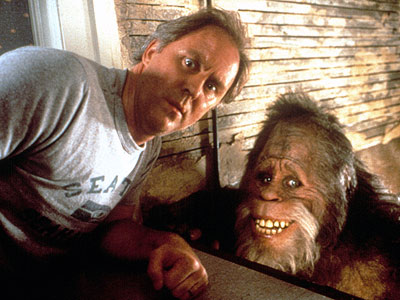
The first original script I ever wrote* back in fourth or fifth grade was one called Bigfoot's Vacation, in which Bigfoot - having come out of hiding and
subsequently climbed the ladder as one of the world's most renowned paleontologists - travels to Scotland to prove the existence of the Loch Ness Monster. I don't have a copy of it anymore, but I remember the ending: a scuba gear-suited 'Foot discovers the secret lair of Loch Ness, where the Monster admonishes him for having revealed himself to homo sapiens and thus taken some of the mystery
out of their lives, at the
same time making himself a little less special. This argument convinces Bigfoot not to share his discovery with the science world, and after returning to Northern California he builds a spaceship to journey to other planets where he can possibly start over again with a new alien society as a rarely-glimpsed recluse. (His friend the Yeti would have found him despondent on the latest of several unoccupied planets at the beginning of my intented but never written sequel, The Big Foot Bang Theory.)
Cut to 20 years later. One of my favorite moments from my sister's December 2009 wedding was sitting in the hotel room the night before the ceremony with my 36-week pregnant wife watching a documentary on the search for Bigfoot. It had been a surreal day - after driving six hours down to Virginia, I'd been immediately tasked with making a run with my brother to the airport to pick up some late wedding guests. While waiting for these strangers to pass through the Dulles
gates, I heard my brother whisper-shout "Oh shit, Joe Mantegna!" I turned around and, sure enough, there was Fat Tony himself strolling through the terminal. 'Celebrity sightings are like Bigfoot sightings,' I mused while lounging on the hotel room bed taking up space that rightfully should have belonged to my wife. 'The lesser amount of exposure time, the stronger the mysterious aura that remains.'
Anyway, the TV program was kind of amazing. It didn't interview specialists, scientists, researchers - nobody with abbreviated letters following their name. The cast was made up entirely of backwoods yahoos in jean vests and caps with gas station logos. None of them claimed to have actually seen the mythic cryptid, nobody produced a photo or footprint impression to back up the story of an encounter. They all treated the subject like the existence of a 9-foot ape
man was a given, that they knew the creature lived among them and were just telling us viewers at home a few things we might not have known about these very real animals. One guy, bald on top with long hair in back and bushy sideburns, related a story of one night where unseen intruders hurled stones at his pickup truck. The idea that these were bored, dipshit high school kids never seemed to cross his mind: it was a family of Bigfeet, warning him in a threatening yet harmless way not to venture too far into
the surrounding wilderness.
Check out this report of a classic 1924 sighting:
"Fred Beck claimed that he and four other miners were attacked one night in July 1924, by several 'apemen' throwing rocks at their cabin in an area later called Ape Canyon in Washington. Beck claimed the miners shot and possibly killed at least one of the creatures, precipitating an attack on their cabin, during which the creatures bombarded the cabin with rocks and tried to break in. The incident was widely reported at the time. Beck wrote a
book about the event in 1967, in which he argued that the alleged creatures were mystical beings from another dimension, claiming that he had experienced psychic premonitions and visions his entire life of which the apemen were only one component."
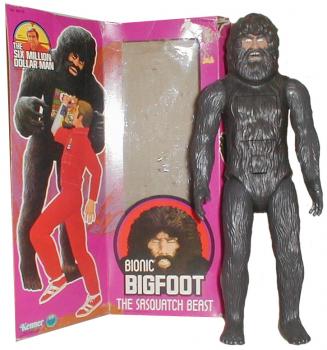 I don't read passages like that and think "Oh well it must be true, there were so many witnesses!" Trying to use actual facts and scientific evidence as backup is overrated**; instead, I think "It's so fucking incredible that these guys really believe this story and stuck to it long enough to write books about the incident four decades later." Mystical beings from
another dimension!
Nude conspiracies! Mothman vs Bigfoot! The lore is endlessly engrossing, and has remained durable and expansive from one generation to the next. Whatever this collective madness that keeps the spirit of Bigfoot alive, it's infectious; people's enthusiasm for the subject rapturous. How are you supposed to ignore a guy at a party who regales the guests with a story of how he barely escaped a sasquatch with his life? On the flip side of the coin, who would want to waste time with the
assholes who ruin it for others - what fun is it to disprove Bigfoot sightings? And wouldn't going out of your way to proove the non-existence of Bigfoot make you feel like even more of an idiot than people who fervently believe in him? How is devoting one's life to the search for Bigfoot any different from "theological positivists" who finance excursions to hunt for Noah's Ark? Are those doofuses any more legit than the BFRO (Bigfoot Field Researchers Organization)? I honestly think it would
be awesome to be a BFRO-er; unfortunately, membership is by invitation only - you have to know a member and be invited on expeditions, then recommended for initiation, which I don't really have time for. Instead, I'm just really glad they're out there making Bigfoot exist by chronicling tales of Bigfoot engagements and photos of impossibly large footprints. That kind of dedication is what makes TV programs viewed on the night before your sister's wedding every bit as memorable as the blessed event
itself, and why people like my (adult) buddy Scott Runnels have wet dreams about getting it on with a sasqutch (true story!)
I don't read passages like that and think "Oh well it must be true, there were so many witnesses!" Trying to use actual facts and scientific evidence as backup is overrated**; instead, I think "It's so fucking incredible that these guys really believe this story and stuck to it long enough to write books about the incident four decades later." Mystical beings from
another dimension!
Nude conspiracies! Mothman vs Bigfoot! The lore is endlessly engrossing, and has remained durable and expansive from one generation to the next. Whatever this collective madness that keeps the spirit of Bigfoot alive, it's infectious; people's enthusiasm for the subject rapturous. How are you supposed to ignore a guy at a party who regales the guests with a story of how he barely escaped a sasquatch with his life? On the flip side of the coin, who would want to waste time with the
assholes who ruin it for others - what fun is it to disprove Bigfoot sightings? And wouldn't going out of your way to proove the non-existence of Bigfoot make you feel like even more of an idiot than people who fervently believe in him? How is devoting one's life to the search for Bigfoot any different from "theological positivists" who finance excursions to hunt for Noah's Ark? Are those doofuses any more legit than the BFRO (Bigfoot Field Researchers Organization)? I honestly think it would
be awesome to be a BFRO-er; unfortunately, membership is by invitation only - you have to know a member and be invited on expeditions, then recommended for initiation, which I don't really have time for. Instead, I'm just really glad they're out there making Bigfoot exist by chronicling tales of Bigfoot engagements and photos of impossibly large footprints. That kind of dedication is what makes TV programs viewed on the night before your sister's wedding every bit as memorable as the blessed event
itself, and why people like my (adult) buddy Scott Runnels have wet dreams about getting it on with a sasqutch (true story!)
I think the "Spanish Fry" episode of Futurama summed it up best:
"In the dense forests of the Pacific Northwest dwells the strange and beautiful creature known as Bigfoot, perhaps. Sadly, logging and human settlement today threaten what might possibly be his habitat. Although if it's not, they don't. Bigfoot populations require vast amounts of land to remain elusive in. They typically dwell just behind rocks but are also sometimes playful, bounding into thick fogs and out-of-focus areas. Remember, it's up
to us. Bigfoot is a crucial part of the ecosystem, if he exists. So let's all help keep Bigfoot possibly alive for future generations to enjoy unless he doesn't exist."
It is up to us! "Bigfoot exists in all of us," is the point I'm trying to make here without actually using those specific words, and his legend endures throughout our American culture like Mickey Mantle or the atomic bomb. Why else would he have been immortalized so many times in feature films? Why else would Marvel turn him into a beloved Canadian superhero? In Jackson County, Oregon there is a famous "Bigfoot
trap" that's been around for almost forty years. In 1969, Skamania County, Washington passed a law declaring that "any willful, wanton slaying of such creatures shall be deemed a felony" that's still on the books today (although the law was passed on April 1, the country commissioner was quoted as saying "This is not an April Fool's Day joke...there is reason to believe such an animal exists.") It's a dream of mine to one day write the libretto for a musical based on Bigfoot
sightings alone, without even going into the alleged history or actual "discovery" of the beast himself. I feel the same way Spielberg did in an interview during the making of Close Encounters of the Third Kind in which he said he didn't believe in UFOs, but he believed in people who did. That's what really counts, and what makes me want to see a movie where the big guy flips a dude off a motorcycle in front of a half-naked chick tied to a tree in the background as Colonel Sanders and a cop with a machine gun look on in horror...

Ok, now that all that's out of the way, on to the movie...
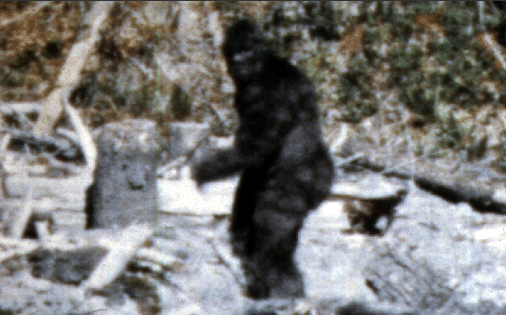
The obvious "oddity" draw to this particular rendering of the Bigfoot legend is of course the bizarre tagline on the cover of the video: "America's abominable snowman...breeds with anything!" So right off the bat, this film is telling me something about Bigfoot I was not aware of. We all know him to be tall, hairy, elusive... yet somehow his reputed low standards is not a quality that has stuck over
the years. This isn't even posed as a question like the movie's alternative tagline, "Has a 150 year old legend come true?" (how can a legend "come true?" Wishes come true - wouldn't a legend TURN OUT to be true?) Nobody's asking "What would Bigfoot breed with?", it's an open statement: this beast will breed with anything! Exclamation point included, like it's something to get really excited about! But what does that mean exactly? Would he fuck a lawnmower? Make
it with a mound of dirt? Impregnate a jellyfish? Is that upside down cyclist
or the machine gun-toting cop on the cover in for a very uncomfortable encounter with the mythic creature? Which of these characters is in danger of being defiled by a giant hairy monster??
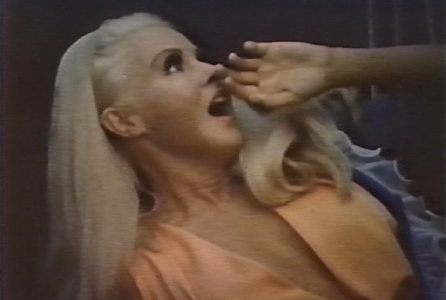
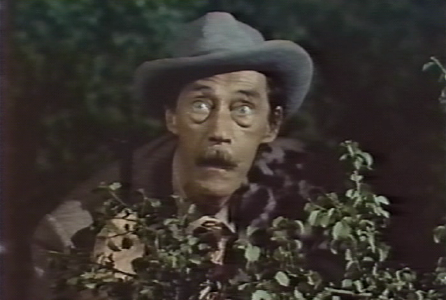

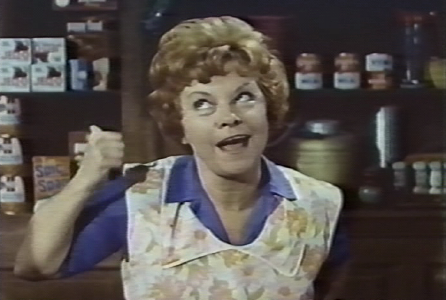
That would go a long way towards explaining why nobody ever reports having a close encounter with Bigfoot - they're a little too "close" to talk about with any shred of dignity (although I guess things along these lines have in fact been reported...also, humility never stopped people from rattling
onabout alien anal probes.) Anyway, my main question going into the movie was whether or not the filmmakers would be addressing the incalcuable number of questions this tagline brings up?
The answer is: not exactly. However, breeding is on the big guy's brain. The Bigfoot featured in this movie is in fact very interested in "breeding" with a Mamie Van Doren-esque platinum blonde. That really doesn't qualify as anything; in fact, it suggests that he has a very specific "type." Even if non-Bigfoot fellas were presented with the above four specimens and asked which they would prefer to "breed"
with, most would - arguably - choose the gal on the top left (I'd pick John Carradine, but that's just me.) Turns out Bigfoot's like one of those guys with an online dating profile: he says he isn't particular and makes a point of not forbidding fatties to respond to his personal ad, when all along he actually had a pretty good idea what he'd like to "shag." To be fair, the Bigfoot in this movie doesn't actually select his breeding partner - she's brought to him like a sacrificial lamb by
"lesser" Bigfoots, chosen from a cache of five similarly kidnapped individuals. This Bigfoot subgroup has set up a very specific breeding program, as related by the blonde captive to her fellow female prisoner when she suddenly turns into Pistachio Explaini and correctly guesses that the species is dying and needs to repopulate; they even have a li'l critter who she surmises is a bigfoot-human hybrid. "The only thing I can figure out is that they're a dying race, and
they want to reproduce more of their own kind." (Well how the hell did she figure THAT out?? That's a pretty astute deduction from a lot of grunting and chest-pounding.*** Unless maybe this kind of the thing has happened to her before?)
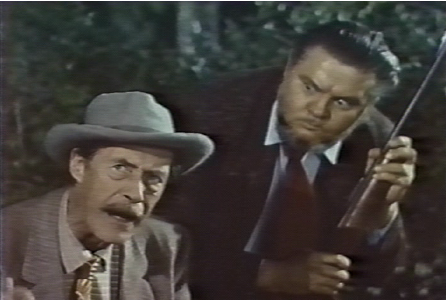
So that's the creatures' scheme, the basic "underground cannibals of Raw Meat" plot of stealing women and propagating their species. Of course, the more Bigfeet in the picture, the more likely their discovery, which is why a pack of eight to ten "young college people" on imported Yamahas run afowl of the beasts.
When one of their number is taken, her boyfriend motors to the local general store and before you know it two sleazy salesmen, two cops and a couple extra mountain rangers are on the monsters' trail. There are half-assed attempts to set up some kind of class conflict between the hippy bikers and the local law enforcement, but they're all equally intolerable. Slightly less offensive is Southern gentleman Jasper C. Hawks (no doubt kin to Wise Blood's Asa Hawks) played by John Carradine. Remember
that
very memorable part in Fritz Lang's Man Hunt**** where Carradine, as the sinister Herr Jones, stalks Walter Pidgeon down the dark tube tunnel only to get thrown onto the third rail during a struggle and end up as fried sauerkraut? This movie has a similarly memorable scene where...no, just kidding. Nothing he does here is particularly memorable. But he seems to be having a good time grifting his way around the backroads of the Northwest, berating his fat colleague and being held captive by the creatures
he was trying to snag for a sideshow (he and the fat guy end up tied up on tiny trees next to the girls - are they getting raped to? Does this movie's beast put the "bi" in Bigfoot? (Note to self: remove before publishing)). Then there are three people living up on the mountain, a Native American female (who cries out the name "sasquatch!" for the viewers' education), a dude in a flannel shirt (shown between Bigfoot's legs in the banner image at the top of the page, referencing
Dustin Hoffman in The Graduate) and a gruff fellow missing his left arm. You guessed it: Bigfoot took that arm - this guy is the Ahab of the story, although after he participates in the destruction of the creature he gives a hilarious kind of resigned "Well, that takes care of the guy who ripped off my arm." Then there's the blonde, who has her own unique way of entering these mounting human-Bigfoot tensions.
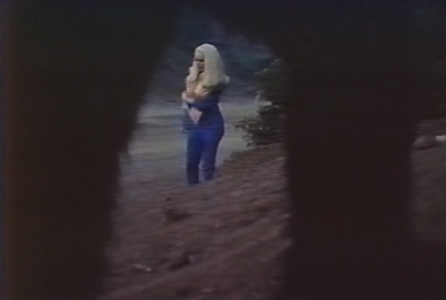
The blonde opens the movie by driving to a private airport, getting into a plane, then flying around a while before freaking out because of some unexplained problem. She bails out and parachutes into the woods, strips out of her jumpsuit under which she's wearing a revealing dress with a very short skirt. But she has the misfortune of landing right in front of a Bigfoot (not
the Bigfoot) and spends most of the rest of the movie tied to a ridiculously small tree screaming. This whole sequence reminds me once again of that story about the first draft of the Piranha screenplay where the writer couldn't think of any motivation for the campers to get into the water, so he had a bear chase them; then he couldn't think of why the bear would be motivated to chase the campers so he added a forest fire to excite the bear into a believable "camper chasing"
frenzy (because
campers never go swimming when their camp is by a river and bears never attack people when they're hungry/threatened etc.) Why did she have to drive to the airport, exit her car, get in the plane, take off, fly around for a while, then freak out as the engine inexplicably starts to fail, bail out and land in Bigfoot territory? Why couldn't she just have been hiking in the woods? One excuse is that the filmmakers may have wanted to establish that Bigfoot's stomping ground is a remote area that nobody would
try
to get to on purpose; but if that's the case, why have so many other characters - ones who bike up, drive up, and live there already - just happen to wander into the same spot? Is it because the director is obsessed with vehicles and transportation? (More on that in a minute.) How does that work into the search for Bigfoot (given that the monster truck had yet to make its debut at the time the film was released)? Maybe they just happened to have free access to a plane and figured it would add production
value? That's why these movies are so interesing and weird, their narrative logic is sometimes just fucking nuts. You could spend a lifetime trying to figure out why the filmmakers decided to present their story the way they did. Say what you will - you can't accuse them of lazy filmmaking.
These filmmakers couldn't have taken very long to decide which story they were going to tell. I'll just say this: one of the characters literally describes BF as "the 8th Wonder of the World!" Yessir, it's your classic "monster finds girl tied to a tree, monster fights another creature in front of girl (a bear not a T-Rex, which is weird cuz there's no forest fire to prompt this particular bear to attack Bigfoot), monster wins fight and beats
chest triumphantly,
monster carries girl off with amorous intentions (which are rejected), monster is killed, girl doesn't understand why she feels so sad about the monster's death" story. Carradine's Jaspar Hawks is the dollar-eyed, countrified Carl Denham of the story, trying to catch the beast to put him on display for the general public. Carradine wants to capture the "varmit" so he can live "high on the hog" for the rest of his life, since he's "plum tired" of being
on the road.
Just to cover all the bases, the video box even promises "The greatest monster since KING KONG!" according to "The Post" (which I supposed could just be a literal, inanimate post on the set that one of the producers wrote graffiti on to get the cast and crew pumped.) What's lacking from this redux of the classic film is a hero to root for. The bike clique are all faceless and dull, the one-armed man sits out until the final scene, the fat guy with Carradine
is an idiot who looks like he's constantly about to break loose with a bowel movement. Then this fucking crazy looking guy gets to be the one to dynamite the hell out of Bigfoot?

...I think it's safe to say, in this case, 'twas no Beauty who killed the Beast.
I like that the details of the monsters syncs up with the more reliable and consistent reports from sightings and findings of the BFRO. Most people think of Bigfoot as a solo creature, the last of his kind or whatever (easier to understand why a single specimen would be so hard to find) but most witnesses claim to have come upon more than one 'foot:
a small group of them, as presented in this film. Many of the movie's Bigfoot pack are lady Bigfeet, which is also a common insistence in Bigfoot lore: in fact, the famously filmed Patterson-Gimlin creature is supposed to be a female. I don't know why the main Bigfoot isn't into these sasquatch squaws; maybe the tagline should have been "breeds with anything...unless it's willing!" Nine feet is the estimated height most experts agree on, and most of what we see of this Bigfoot makes him seem impossibly
huge (in fact, aspiring Bigfoot hunters should be forewarned not to target 7-foot Chicago Bulls center Ömer Asik. Dude's
a giant.) Several descriptions include a noticable rank scent in the area of a recent Bigfoot appearance, which Carradine evokes by constantly complaining of a "peculiar OH-dah!" or "musty smell" and compliments with a swift insult to the fat guy who doesn't smell it: "All you smell is you!") Even the human relationship to the beasts is culled from truth - although there are 947 characters in this movie, not one of them dies...just as there are no
reported Bigfoot-related fatalities in real life! Of course all this kind of gets thrown out when you consider how in such an unbelievably short amount of time, 15 people - representing four unconnected groups - could come to unquestionably verify the existence of this race and engage with its members when not one of the 6.92 billion people in the world have managed to capture or kill a Bigfoot. But that's easy enough to overlook.
There are elements to this film...I hesitate to call them "arty," but if we were talking about a film made today rather than a 40-year-old Bigfoot movie, there would be no label more apt...that are almost experimental. The credits come 9 1/2 minutes after the movie has started, a bold move which Scorsese paid hommage to in The Departed four decades later. There are some ultra-lengthy "real-time" shots, particularly
a long take of the Bigfoot hunters walking uphill that's just 90 seconds of John Carradine's back, that must have inspired Bela Tarr. Most notably, there are an abundance of car and motorcycle POVs. This is a 83 minute movie, and I'd say about 1/6th of it, without exaggerating, is people riding in cars or on motorcycles, and of that I'd say every 1 out of 5 shots is a car or motorcycle POV. Humans are rarely glimpsed in these sequences; more prominent are headlights and tailgates - it's practically Bresson-ian!
I thought the first
scene of the "college kids" making their way through the trees on their bikes went on a little long, but after the third or fourth extended series of the same kind of shaky, repetitive action I figured the director has an agenda here. It's like that ridiculously interminable motorcycle montage in Charly, but this guy doesn't take away from his vehicles' glory by breaking the shots up into overlapping split screens: he wants you to see these bikes and cars and airplane. Is he trying
to
make a statement about how technology has overwhelmed human society, so that they can not conceive of and have no way of dealing with the "150 year old" threat of a hairy monster living among the sticks? Or a statement about how noise pollution and human intrusion will eventually build to total deforestation and eradication of the Bigfoot clan? A death toll for everything unknown and mysterious.
Does it matter that these things were clearly not done on purpose? Absolutely not, because in its own low-budget, quick-sell way this movie is, intentionally or not, kind of the perfect way to go about shooting a film about Bigfoot. The perfect Bigfoot movie would one in which Bigfoot never appeared at all. If he has to play a role, the movie should be shot entirely out of focus. This one isn't (not entirely), but there's a lot of quivering hand-held
camerawork, horrible lighting, disorienting transitions and long long takes of absolutely nothing. I figure for the ideal Bigfoot movie he would at the very least have to never be clearly discernible from the dark forest around him - like his photos and film strips and re-enactments the beast would have to be constantly out of sight and in the shadows. And that's exactly how they did it: you hardly ever see the creature in this movie. Almost every action scene with Bigfoot is a very fuzzy long
shot and everything else is shrouded in darkness. Like the underdeveloped images of Paris in Stan Brakhage's The Dead, most of Bigfoot's close-ups are shot at night with no visible light source to help define his features. Yet his presence is always felt throughout the movie, like he's a natural part of the forest or the night air.
Here are two shots from the scene where Bigfoot takes on the bear - keep in mind that in both of them the wrestling beasts are supposed to be directly in front of the blonde:
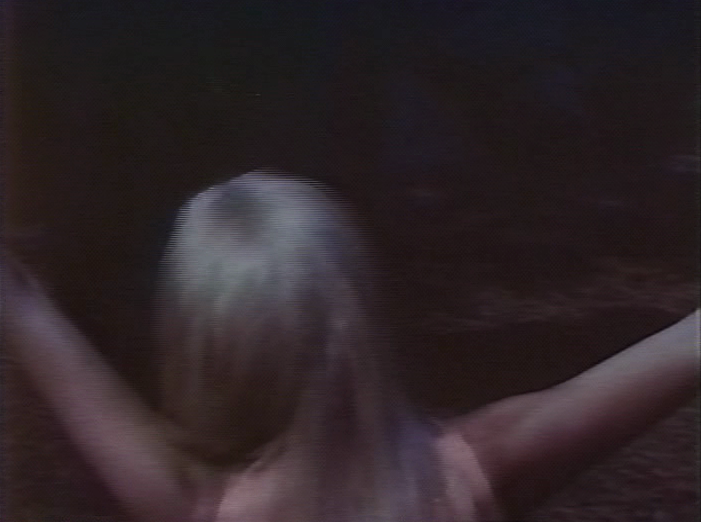
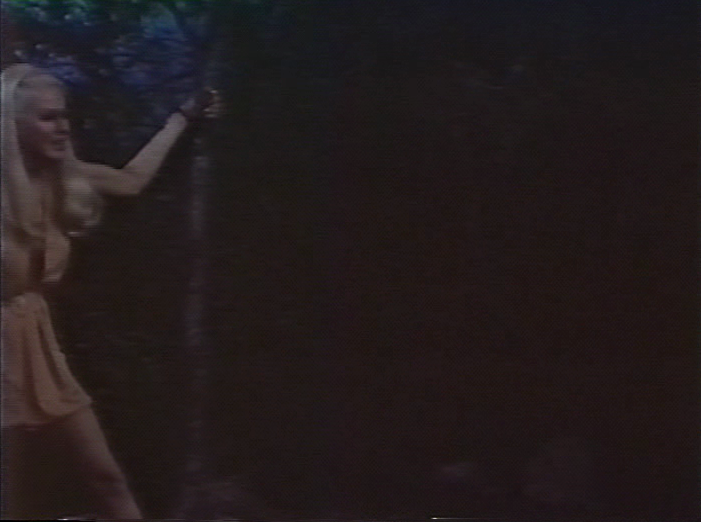
(Maybe he rapes the bear and we just can't see it?
That would be more in line with "breeds with anything!")
After the girl escapes and runs out of the shot, and it just looks like black. Brilliant! Somehow these guys stumbled upon the consummate approach to a Bigfoot biopic, and it comes from the same place as the (allegedly) fake footage of "authentic" Bigfoots: the need to cover up telling costume or makeup tricks, to create an illusion, to capture the mystique of the unconfirmed creature. It's a style with a dual purpose, to pay tribute
to the real life recorded encounters and to suggest with the movie "How can we show you a clear shot of Bigfoot, NOBODY KNOWS WHAT HE LOOKS LIKE!" In some of the shots, he's so incredibly dark it looks almost like he's been cut out of the picture:
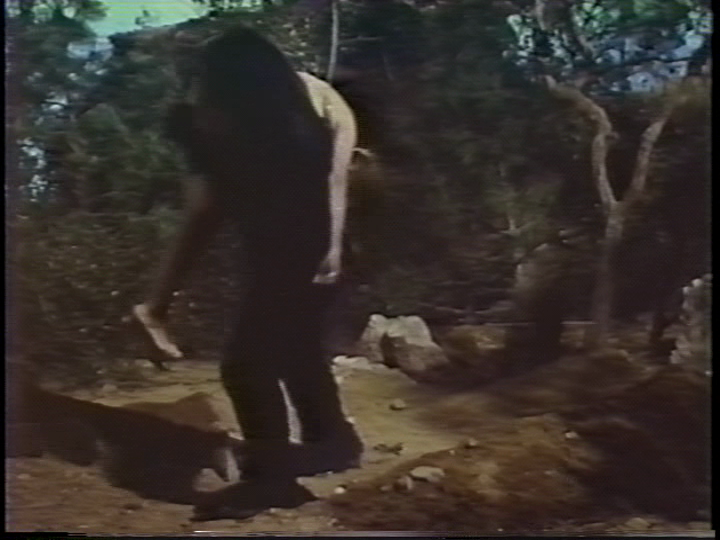
The vhs cover is excellent, but it depicts a Bigfoot in full view, rampaging and leaving no ambiguity as to his enigmatic existence. Who wants to see that? The same people who'd want to see a friendly sasquatch sitting on the couch, watching MTV, sharing junk food with John Lithgow, that's who. This is a much weirder and more appropriate way to make a Bigfoot movie. Is it genuinely good? Not at all. But it's absolutely perfect.
APPENDiX,
or what i later learned
I figured the movie had to be old, since it specifically stated "color" on the box. It was made in 1969, released the following year and as far as I can tell is the first major movie made about Bigfoot. Although Val Guest's The Abominable Snowman had come out much earlier in 1957, this film pre-dated The Legend of Boggy Creek - which is technically about the Fouke monster anyway - by two years and The Capture of
Bigfoot, which Lloyd Kaufman describes as "the best film ever made about a man in a fur coat falling down in the snow...over and over and over again," by ten. Inbetween those two movies were such gems as 1974's Shriek of the Mutilated, by shlockmeister legend Michael Findlay, 1976's Creature from Black Lake, 1977's Sasquatch, The Legend of Bigfoot and 1977's Return to Boggy Creek.
Most significantly, this film was made two years after the release of the Patterson-Gimlin film, the first "Bigfoot footage." Some people say Patterson (who had written a book about the possible existence of the Abominable Snowman a few years earlier) was actually planning to make the world's first feature-length Bigfoot movie and his infamous shot started out as a camera test of the costume, but that the footage looked so believable
he decided to tell everyone it was authentic.

Co-writer-director Robert F Slatzer must have been quite the conspiracy buff: for years he claimed to have evidence that Marilyn Monroe was killed because of her relationship with JFK. These accusations have been largely discredited in light of his other, even more outrageous claim: that he himself, Robert F Slatzer, had married Marilyn
while on a secret vacation in Mexico with the starlet and stayed married to her for three whole days (this was later officially dismissed when it was determined that Monroe was somewhere else entirely on the date of their alleged nuptials.) But Bob stuck to his story like any good Bigfoot believer, appearing on E! Monroe docs and a Marilyn TV biopic in the early 90's. He also wrote two books about her. It would be wrong to share Slatzer's assumed belief in Bigfoot and not this other stuff, so what the
hell I
buy it.
The producer was Anthony Cardoza, who made four movies in a row that would end up being featured on Mystery Science Theater 3000, including Slatzer's own The Hellcats. Somehow Bigfoot was spared the "honor."
The supporting cast includes Bing Crosby's son, Robert Mitchum's son and Sigorney Weaver's uncle Winstead "Doodles" Weaver. I don't know what it is with these recent Video Oddities picks and suicide among their casts, but both Crosby and Doodles ended up killing themselves via shotgun to the head in the 80's.
John Carradine made Bigfoot the same year his frequent co-star John Wayne was winning an Oscar, but don't try to tell me the Duke got the better end of that deal.
This was the final film for Joi Lansing, the parachuting blonde who becomes Fay Wray to Slatzer's Kong, a Marilyn Monroe/Jayne Mansfield type notable as the blonde who blows up in the car at the end of that famous opening shot from Orson Welles' Touch of Evil. Sadly, she died of breast cancer in 1972 at age 43.
The role of Bigfoot is the only credited film part for the stellar Mr. James Stellar.
The filming locations were undisclosed at the time, as they were selected for their alleged Bigfoot sightings (likely Tehama Country, CA.) That fact makes me think the filmmakers really were trying to stick as close to reported Bigfoot lore as possible, and it's kind of charming that the film wanted to share somewhat in its creature's elusiveness.
~ 2011 ~
* My first script was a sequel to Teen Wolf called Teen Wolf Too - yes, the "two" was spelled "too" because it was about a DIFFERENT Teen Wolf. Hollywood ripped that one off.
** Although I will say this: Many people have come forward to claim that they were the man in the suit in Patterson-Gimli film, thus debunking the classic bit of footage. But how about this logic: if there were two men present (Patterson and Gimli), why wouldn't one of them played the "phony" creature? Why would they need a third guy? It just goes to show that for every person who (allegedly) tries to get famous by saying he saw Bigfoot, there are ten who try to get famous by proofing him wrong.
*** I guess it's better than a scene where the blonde finds all the missing campers' video cameras with footage of Bigfoot abducting and raping the campers.
**** Interestingly, both Bigfoot and Man Hunt open with footprints in the dirt.
COMING SOON...
MY BROTHER HAS BAD DREAMS!
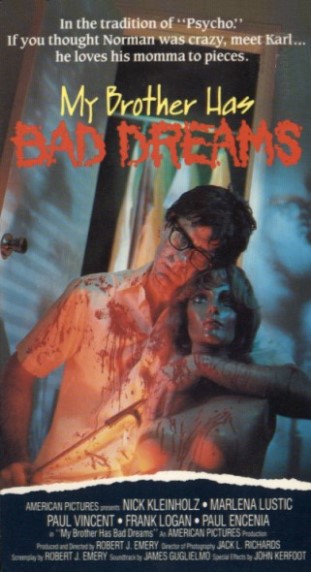
 For those just tuning in: what I'm doing in this series is heading down to the local video store and finding interesting movies I've never heard of. For younger readers, a "video store" is an establishment that you can walk or drive to and rent Video Home System cassettes, also known as VHS tapes, from an actual person and take it home for your own entertainment purposes (you gotta bring it back to the store when you're done, though.)
For those just tuning in: what I'm doing in this series is heading down to the local video store and finding interesting movies I've never heard of. For younger readers, a "video store" is an establishment that you can walk or drive to and rent Video Home System cassettes, also known as VHS tapes, from an actual person and take it home for your own entertainment purposes (you gotta bring it back to the store when you're done, though.)



 I don't read passages like that and think "Oh well it must be true, there were so many witnesses!" Trying to use actual facts and scientific evidence as backup is overrated
I don't read passages like that and think "Oh well it must be true, there were so many witnesses!" Trying to use actual facts and scientific evidence as backup is overrated











